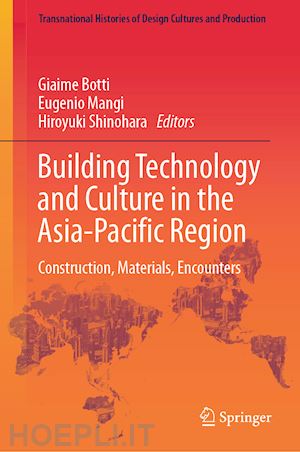
Questo prodotto usufruisce delle SPEDIZIONI GRATIS
selezionando l'opzione Corriere Veloce in fase di ordine.
Pagabile anche con Carta della cultura giovani e del merito, 18App Bonus Cultura e Carta del Docente
This book compiles a curated selection of texts authored by architects and scholars hailing from Asia, Europe, and North America. Their research, often intertwined with practical applications, delves into the intricate relationship between material culture, technology, and architecture within the broader cultural and social milieu. Three keywords—construction, materials, encounters—serve as the organizing framework for the book, guiding readers through a diverse array of case studies and experiences where these elements intertwine seamlessly. Indeed, these terms are intricately interwoven, reflecting the inseparability of technology from culture.
The first part of the book delves into the poetics and theoretical underpinnings of construction, drawing from the works of various designers across China, Japan, and India. The subsequent section navigates the terrain of construction materials, exploring their evolution, manufacturing processes, and utilization, with a particular focus on diverse timber products and bamboo. The final part of this compilation embarks on a journey through historical encounters between the East and West spanning over a century. It meticulously investigates the exchanges, misunderstandings, and innovations catalyzed by these interactions. Collectively, these texts offer a profound and original perspective on the myriad experiences and challenges associated with the intricate interplay between technological advancements, tectonic preferences, and socio-cultural dynamics within the architectural landscape of the Asia-Pacific region.
Introduction - Bridging Technology and Culture in Architecture.- Patterns Redefinition in Beijing East Qianmen, Kengo Kuma Office in Damochang 220 Courtyard House.- Chinese Vaulted Avant-garde Architecture. Materials and Tectonics as Design Tools for the Pursuit of Monumentality.- All That Glitters Is Not Gold: Laurie Baker’s Alchemy in Brick.- The Reciprocal Development of Craft and Industry in Twentieth-century Japan Through the Lens of Plywood as a Material.- Toyo Ito’s Wood Architecture Reimagined: A Critique of Modernist Ideology.- Hyperboloid Structure, also Known as Reciprocal Tower, in Bamboo Architecture.- The Cross-border Spread and Modernization of Modern Treaty Ports Cities: The Jardine Matheson Warehouse of Tianjin.- The “Chinese Curved Roof” for a Christian University: Interactions Between Building Technology and Cultural Perception in the Case of the University of Nanking.- Digging Cultures of Production Using Design Practice: Transforming the Main Oxygen Factory Workshop in Shougang, Beijing.
Giaime Botti, who holds a Ph.D. in Architecture from Politecnico di Torino, currently serves as an Assistant Professor in the Department of Architecture and Built Environment at the University of Nottingham Ningbo China. With prior appointments as an Assistant Professor at Pontificia Universidad Javeriana in Bogotá, Colombia, and professional engagements in both the Netherlands and China, Botti brings a wealth of international experience to his academic pursuits. His research is concentrated on three primary areas: twentieth-century architectural and urban history in Latin America, contemporary architecture and urban design in China, and the phenomenon of architectural globalization.
Eugenio Mangi, Ph.D. in Architecture Design from Università degli Studi di Palermo, serves as an Assistant Professor in Architecture at the Department of Architecture and Built Environment, University of Nottingham Ningbo China. With an extensive academic background, he has also heldthe position of Adjunct Professor for the Environmental Design Studio within the Master Program at the College of Design and Innovation, Tongji University.
Drawing from his rich professional experience, Eugenio has worked as a practitioner in Spain, Italy, and China. His scholarly pursuits center around the sustainable urban transformation process in China, emphasizing local community engagement and participation. Additionally, his research interests encompass the exploration of Chinese heritage re-use, showcasing a multifaceted commitment to advancing the understanding and application of architectural principles in diverse cultural contexts.
Hiroyuki Shinohara is Assistant Professor in the School of Architecture at the Chinese University in Hong Kong. Prior to that, he was Assistant Professor in Architecture and Built Environment at the University of Nottingham Ningbo, China. He has a master of architecture from Harvard University Graduate School of Design anda Ph.D. from Nagoya Institute of Technology in Japan. His research revolves around the concept of materiality in the topics of Chinese urbanism, architecture and language, building technology and architectural pedagogy.











Il sito utilizza cookie ed altri strumenti di tracciamento che raccolgono informazioni dal dispositivo dell’utente. Oltre ai cookie tecnici ed analitici aggregati, strettamente necessari per il funzionamento di questo sito web, previo consenso dell’utente possono essere installati cookie di profilazione e marketing e cookie dei social media. Cliccando su “Accetto tutti i cookie” saranno attivate tutte le categorie di cookie. Per accettare solo deterninate categorie di cookie, cliccare invece su “Impostazioni cookie”. Chiudendo il banner o continuando a navigare saranno installati solo cookie tecnici. Per maggiori dettagli, consultare la Cookie Policy.